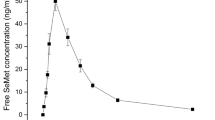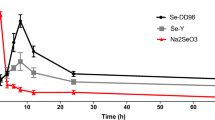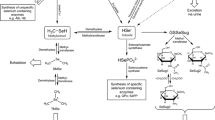Abstract
l-Selenomethionine (SeMet) and sodium selenite are widely used selenium nutritional supplements with potential benefit in preventing cancer. However, supplementation is not without risks of toxicity if intake is too high. The aim of the present study was to investigate SeMet and selenite metabolism in the gastrointestinal tract with particular focus on the formation of the volatile selenium excretion products, dimethylselenide (DMSe) and dimethyldiselenide (DMDSe). Adult male Wistar rats (n = 5) were euthanized, their intestinal tracts removed and the contents of jejunum, ileum, caecum and colon used to prepare 10% suspensions in saline. SeMet and selenite (0.5–0.6 mM) were then incubated with these suspensions at 37°C for 3 h. Caecum and colon contents were the most metabolically active towards SeMet with 30% and 15% metabolized over 3 h. DMDSe was the only volatile selenium metabolite detected accounting for 8.7 ± 1.3% of the selenium lost in caecum contents. Selenite was completely metabolized by caecum contents and 73% by colon contents under the same conditions forming DMSe (5.7 ± 0.9% of the selenium lost in caecum) and a precipitate of red amorphous elemental selenium. Based on previous literature and these results, we conclude that the gut microbiota contributes to the excretion of excess selenium through the production of methylated selenium compounds and elemental selenium.



Similar content being viewed by others
References
Navarro-Alarcon M, Cabrera-Vique C (2008) Selenium in food and the human body: a review. Sci Total Environ 400:115–141
Schrauzer GN (2000) Selenomethionine: a review of its nutritional significance, metabolism and toxicity. J Nutr 130:1653–1656
Finley JW (2006) Bioavailability of selenium from foods. Nutr Rev 64:146–151
Rayman MP (2005) Selenium in cancer prevention: a review of the evidence and mechanism of action. Proc Nutr Soc 64:527–542
Clark LC, Cantor KP, Allaway WH (1991) Selenium in forage crops and cancer mortality in US counties. Arch Environ Health 46:37–42
Vogt TM, Ziegler RG, Patterson BH et al (2007) Racial differences in serum selenium concentration: analysis of US population data from the third national health and nutrition examination survey. Am J Epidemiol 166:280–288
Clark LC, Combs GF, Turnbull B et al (1996) Effects of selenium supplementation for cancer prevention in patients with carcinomas of the skin: a randomized controlled trial. JAMA 276:1957–1963
Peters U, Chatterjee N, Church TR et al (2006) High serum selenium and reduced risk of advanced colorectal adenoma in a colorectal cancer early detection program. Cancer Epidemiol Biomarkers Prev 15:315–320
Peters U, Foster CB, Chatterjee N et al (2007) Serum selenium and risk of prostate cancer—a nested case-control study. Am J Clin Nutr 85:209–217
Schrauzer GN (2000) Anticarcinogenic effects of selenium. Cell Mol Life Sci 57:1864–1873
Food and Nutrition Board, Institute of Medicine, National Academy of Sciences (2000) Selenium. In: DRI Dietary Reference Intakes for vitamin C, vitamin E, selenium, and carotenoids. National Academy Press, Washington DC, pp 284–324
Suzuki KT (2005) Metabolomics of selenium: Se metabolites based on speciation studies. J Health Sci 51:107–114
Suzuki KT, Doi C, Suzuki N (2006) Metabolism of 76Se-methylselenocysteine compared with that of 77Se-selenomethionine and 82Se-selenite. Toxicol Appl Pharmacol 217:185–195
Suzuki KT, Kurasaki K, Suzuki N (2007) Selenocysteine β-lyase and methylselenol demethylase in the metabolism of Se-methylated selenocompounds into selenide. Biochim Biophys Acta 1770:1053–1061
Lu J, Bernt C, Holmgren A (2009) Metabolism of selenium compounds catalyzed by the mammalian selenoprotein thioredoxin reductase. Biochim Biophys Acta 1790:1513–1519
Zakharyan RA, Tsaprailis G, Chowdhury UK et al (2005) Interactions of sodium selenite, glutathione, arsenic species, and omega class human glutathione transferase. Chem Res Toxicol 18:1287–1295
Ohta Y, Suzuki KT (2008) Methylation and demethylation of intermediates selenide and methylselenol in the metabolism of selenium. Toxicol Appl Pharmacol 226:169–177
Dungan RS, Frankenberger WT Jr (2001) Biotransformations of selenium by Enterobacter cloacae SLD1a-1: formation of dimethylselenide. Biogeochemistry 55:73–86
Ranjard L, Nazaret S, Cournoyer B (2003) Freshwater bacteria can methylate selenium through the thiopurine methyltransferase pathway. Appl Environ Microbiol 69:3784–3790
Stolz JF, Basu P, Santini JM et al (2006) Arsenic and selenium in microbial metabolism. Annu Rev Microbiol 60:107–130
Ranjard L, Prigent-Combaret C, Nazaret S et al (2002) Methylation of inorganic and organic selenium by the bacterial thiopurine methyltransferase. J Bacteriol 184:3146–3149
Doran JW, Alexander M (1977) Microbial transformations of selenium. Appl Environ Microbiol 33:31–37
Oremland RS, Herbel MJ, Blum JS et al (2004) Structural and spectral features of selenium nanospheres produced by Se-respiring bacteria. Appl Environ Microbiol 70:52–60
Herbel MJ, Blum JS, Oremland RS (2003) Reduction of elemental selenium to selenide: experiments with anoxic sediments and bacteria that respire Se-oxyanions. Geomicrobiol J 20:587–602
Hrdina J, Banning A, Kipp A et al (2009) The gastrointestinal microbiota affects the selenium status and selenoprotein expression in mice. J Nutr Biochem 20:638–648
Schwiertz A, Deubel S, Birringer M (2008) Bioactivation of selenocysteine derivatives by β-lyases present in common gastrointestinal bacterial species. Int J Vitam Nutr Res 78:169–174
Krittaphol W, McDowell A, Thomson CD et al (2009) An improved HPLC method for the investigation of l-selenomethionine metabolism in rat gut contents. Biomed Chromatogr 23:1169–1174
Cabon JY, Erler W (1998) Determination of selenium species in seawater by flow injection hydride generation in situ trapping followed by electrothermal atomic absorption spectrometry. Analyst 123:1565–1569
Sherrard JC, Hunter KA, Boyd PW (2004) Selenium speciation in subantarctic and subtropical waters east of New Zealand: trends and temporal variations. Deep-Sea Res Pt I 51:491–506
Meija J, Montes-Bayón M, Le Duc DL et al (2002) Simultaneous monitoring of volatile selenium and sulfur species from Se accumulating plants (wild type and genetically modified) by GC/MS and GC/ICPMS using solid-phase microextraction for sample introduction. Anal Chem 74:5837–5844
Dungan RS, Frankenberger WT Jr (1999) Microbial transformation of selenium and the bioremediation of seleniferous environments. Bioremediation J 3:171–188
Chatterjee A, Shibata Y, Yoneda M et al (2001) Identification of volatile selenium compounds produced in the hydride generation system from organoselenium compounds. Anal Chem 73:3181–3186
Okuno T, Motobayashi S, Ueno H et al (2005) Purification and characterization of mouse hepatic enzyme that converts selenomethionine to methylselenol by its α, γ-elimination. Biol Trace Elem Res 106:77–93
Okuno T, Kubota T, Kuroda T et al (2001) Contribution of enzymic α, γ-elimination reaction in detoxification pathway of selenomethionine in mouse liver. Toxicol Appl Pharmacol 176:18–23
Dietz C, Landaluze JS, Ximénez-Embún P et al (2004) SPME-multicapillary GC coupled to different detection systems and applied to volatile organo-selenium speciation in yeast. J Anal At Spectrom 19:260–266
Dungan RS, Yates SR, Frankenberger WT Jr (2003) Transformations of selenate and selenite by Stenotrophomonas maltophilia isolated from a seleniferous agricultural drainage pond sediment. Environ Microbiol 5:287–295
Acknowledgements
W. Krittaphol is grateful for a University of Otago Research Grant to support this research. The authors thank Dr. Vicki Livingstone for her advice on biostatistical analysis, Ashley Duncan and Michelle Harper, Department of Human Nutrition, University of Otago for their assistance with GC-MS analysis and Dr Karl Bailey, Trace Element Laboratory, Department of Human Nutrition, University of Otago for assistance with selenium analysis.
Author information
Authors and Affiliations
Corresponding author
Rights and permissions
About this article
Cite this article
Krittaphol, W., McDowell, A., Thomson, C.D. et al. Biotransformation of l-Selenomethionine and Selenite in Rat Gut Contents. Biol Trace Elem Res 139, 188–196 (2011). https://doi.org/10.1007/s12011-010-8653-x
Received:
Accepted:
Published:
Issue Date:
DOI: https://doi.org/10.1007/s12011-010-8653-x




